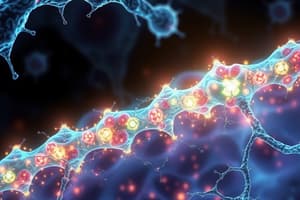Podcast
Questions and Answers
What is generated by glucose metabolism during a sprint when oxygen delivery is inadequate?
What is generated by glucose metabolism during a sprint when oxygen delivery is inadequate?
- Water
- Lactate (correct)
- ATP
- Carbon dioxide
What occurs in skeletal muscle during vigorous exercise?
What occurs in skeletal muscle during vigorous exercise?
- Oxidation of pyruvate > production of pyruvate
- Neither oxidation nor production of pyruvate
- Oxidation of pyruvate = production of pyruvate
- Production of pyruvate > oxidation of pyruvate (correct)
What do red blood cells produce due to the lack of mitochondria?
What do red blood cells produce due to the lack of mitochondria?
- ATP
- Lactate (correct)
- Carbon dioxide
- Water
What happens to glucose metabolism when oxygen delivery is adequate?
What happens to glucose metabolism when oxygen delivery is adequate?
Under what condition is glucose metabolized to lactate?
Under what condition is glucose metabolized to lactate?
What type of metabolism is glycolysis classified as?
What type of metabolism is glycolysis classified as?
Where is the energy released during glycolysis stored?
Where is the energy released during glycolysis stored?
What is the main product of glycolysis?
What is the main product of glycolysis?
How many ATP molecules are produced in the pay-off phase of glycolysis?
How many ATP molecules are produced in the pay-off phase of glycolysis?
Which enzyme is involved in the first step of glycolysis?
Which enzyme is involved in the first step of glycolysis?
Which product is formed in the third step of glycolysis?
Which product is formed in the third step of glycolysis?
What is the role of enzymes in glycolysis?
What is the role of enzymes in glycolysis?
Which pathway breaks down glucose to generate Ribose 5-phosphate?
Which pathway breaks down glucose to generate Ribose 5-phosphate?
Which phase of glycolysis requires the investment of ATP?
Which phase of glycolysis requires the investment of ATP?
How many carbons does each pyruvate molecule contain?
How many carbons does each pyruvate molecule contain?
Which enzyme is responsible for converting glucose to glucose 6-phosphate?
Which enzyme is responsible for converting glucose to glucose 6-phosphate?
What cofactor is required by hexokinase to properly function?
What cofactor is required by hexokinase to properly function?
Which enzyme catalyzes the conversion of glucose 6-phosphate to fructose 6-phosphate?
Which enzyme catalyzes the conversion of glucose 6-phosphate to fructose 6-phosphate?
Fructose 6-phosphate is converted to which molecule in the third step of glycolysis?
Fructose 6-phosphate is converted to which molecule in the third step of glycolysis?
Which enzyme is involved in the breakdown of fructose 1,6-bisphosphate into DHAP and G3P?
Which enzyme is involved in the breakdown of fructose 1,6-bisphosphate into DHAP and G3P?
What is the main significance of the conversion of DHAP to G3P?
What is the main significance of the conversion of DHAP to G3P?
How many carbons are present in glucose?
How many carbons are present in glucose?
Which type of enzyme is hexokinase?
Which type of enzyme is hexokinase?
Which enzyme is responsible for converting glyceraldehyde-3-phosphate to 1,3-bisphosphoglycerate?
Which enzyme is responsible for converting glyceraldehyde-3-phosphate to 1,3-bisphosphoglycerate?
In which step is ATP generated during the conversion of 1,3-bisphosphoglycerate to pyruvate?
In which step is ATP generated during the conversion of 1,3-bisphosphoglycerate to pyruvate?
What is the immediate product of the reaction catalyzed by phosphoglycerate kinase?
What is the immediate product of the reaction catalyzed by phosphoglycerate kinase?
Which enzyme catalyzes the dehydration of 2-phosphoglycerate to phosphoenolpyruvate?
Which enzyme catalyzes the dehydration of 2-phosphoglycerate to phosphoenolpyruvate?
Which molecule is used as an input in the conversion of 3-phosphoglycerate to 2-phosphoglycerate?
Which molecule is used as an input in the conversion of 3-phosphoglycerate to 2-phosphoglycerate?
What type of reaction is catalyzed by glyceraldehyde 3-phosphate dehydrogenase?
What type of reaction is catalyzed by glyceraldehyde 3-phosphate dehydrogenase?
Which intermediate is considered unstable and quickly reacts to the next step?
Which intermediate is considered unstable and quickly reacts to the next step?
What is the end product of the conversion of phosphoenolpyruvate by pyruvate kinase?
What is the end product of the conversion of phosphoenolpyruvate by pyruvate kinase?
Study Notes
Anaerobic Reduction of Pyruvate to Lactate
- During high-intensity exercises like sprinting, glucose is metabolized to lactate when oxygen delivery is inadequate.
- In contrast, when oxygen delivery is adequate, glucose is metabolized to carbon dioxide and water.
Glucose Metabolism
- Glucose metabolism generates ATP to meet muscle contraction demands.
- Glycolysis is a metabolic pathway that breaks down glucose to produce energy.
- Energy released from glycolysis can be stored as ATP, heat, or electron carriers like NADH and NADPH.
Glycolysis
- Glycolysis breaks down glucose (a 6-carbon sugar) into pyruvate (a 3-carbon sugar).
- The process has two phases: preparatory and pay-off.
- The preparatory phase requires an investment of 2 ATPs and converts glucose into two 3-carbon molecules: DHAP and glyceraldehyde 3-phosphate.
- The pay-off phase invests 2 ATPs and produces 2 pyruvate, 4 ATPs, and 2 NADH.
Steps in Glycolysis
- There are 10 steps in glycolysis, involving specific enzymes and resulting in various products.
- The steps are:
- Glucose to Glucose 6-phosphate (hexokinase)
- Glucose 6-phosphate to Fructose 6-phosphate (phosphohexose isomerase)
- Fructose 6-phosphate to Fructose 1,6-bisphosphate (phosphofructokinase-1)
- Fructose 1,6-bisphosphate to DHAP and G3P (aldolase)
- DHAP to G3P (triose phosphate isomerase)
- G3P to 1,3-bisphosphoglycerate (glyceraldehyde 3-phosphate dehydrogenase)
- 1,3-bisphosphoglycerate to 3-phosphoglycerate (phosphoglycerate kinase)
- 3-phosphoglycerate to 2-phosphoglycerate (phosphoglycerate mutase)
- 2-phosphoglycerate to phosphoenolpyruvate (enolase)
- Phosphoenolpyruvate to Pyruvate (pyruvate kinase)
Glyceraldehyde-3-phosphate to Pyruvate
- This process involves the final 5 steps of glycolysis.
- The key features of these steps include redox reactions, substrate-level phosphorylation, and the formation of high-energy unstable bonds.
Important Notes
- Under low oxygen conditions, pyruvate may be converted to lactate.
- Pyruvate is typically used by mitochondria to generate ATP through the citric acid cycle and oxidative phosphorylation.
Studying That Suits You
Use AI to generate personalized quizzes and flashcards to suit your learning preferences.
Description
This quiz explains how glucose is metabolized to lactate during high-intensity activities like sprinting, and how oxygen delivery affects ATP production. It uses the example of Usain Bolt's record-breaking sprint to illustrate the concept.




